
Luca Marini: The analyst at the heart of Honda's MotoGP revival
As Honda rebuilds after its deepest slump, Luca Marini has emerged as a thinking rider whose value goes far beyond the timing screens
More from Misano: why KTM got rid of Zarco, the screw loose in the RC16, Yamaha’s flurry of new parts and the Rossi v Márquez storm in a teacup
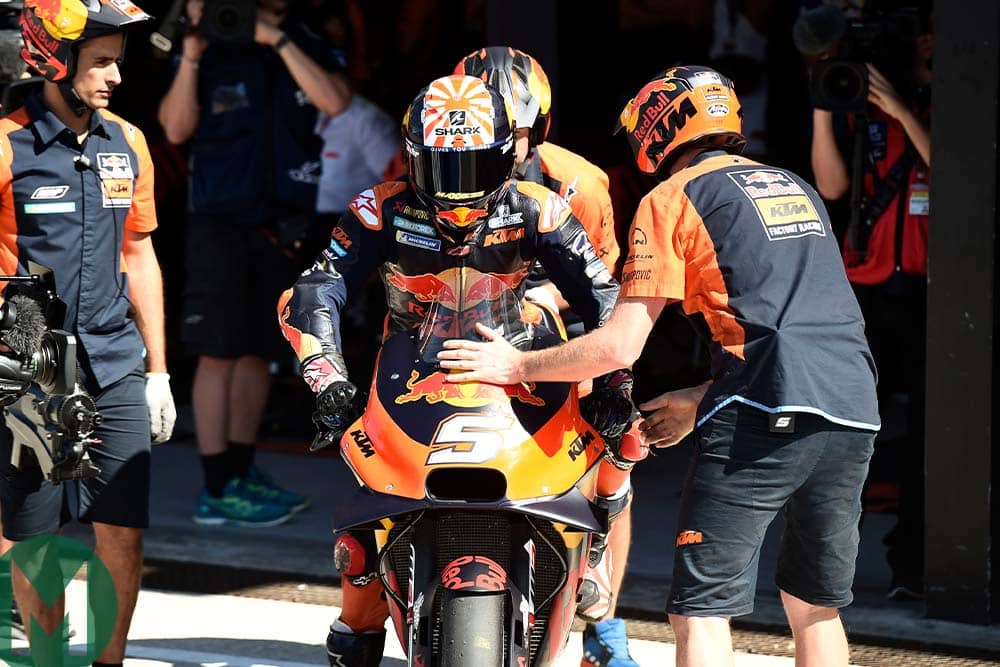
Zarco’s final weekend with KTM Photo: Red Bull
No great surprise that KTM showed Johann Zarco the door, five weeks after he told management that he wanted out of his two-year contract. It wasn’t about preventing the rider taking secrets with him (what secrets?), it was more about the breakdown between the Frenchman, his crew and the factory.
Despite KTM’s recent progress [see below] the relationship between the former Moto2 champ and those around him long ago disintegrated. Morale is a huge factor in motorcycle racing.
Whether you are riding the bike, fettling the bike or developing the bike you have to be utterly dedicated to the exclusion of all else: friends, family, everything. And if the person at the top of the performance pyramid – the rider – has given up, what’s to stop everyone else giving up? Thus, KTM had to remove Zarco as quickly as possible.
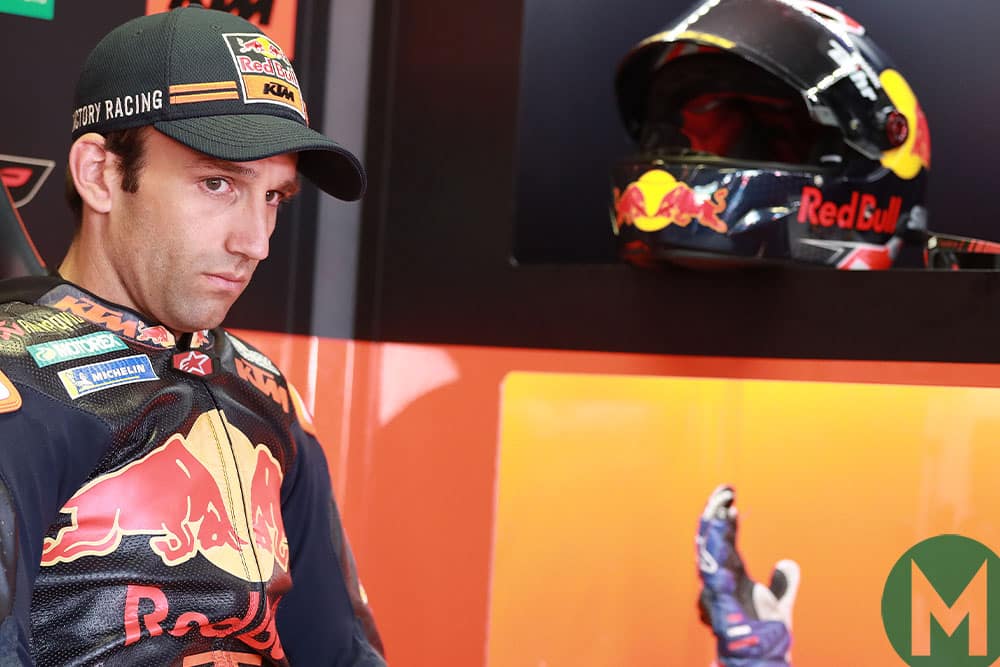
Zarco will no longer see out the season with KTM Photo: Red Bull
Test rider and erstwhile 125cc and Moto2 title challenger Mika Kallio will take Zarco’s place from Aragon. At Jerez last year the Finn beat both KTM full-times Pol Espargaró and Bradley Smith, but ended his season with a nasty knee injury at the Sachsenring.
And what of Zarco, MotoGP’s rookie hero of 2017? If any seats become available for 2020 he will be in the reckoning, but his inability to stay the course with KTM, when other RC16 riders were beating him, won’t have won him many friends in management circles.
It’s been a while since a factory rider has split with a factory so quickly. Valentino Rossi wanted to leave Ducati at the end of his first year with the brand, but gritted his teeth and stayed.
Cal Crutchlow did quit Ducati at the end of the first of a two-year deal, but at least he made it to the end of the season.
Perhaps we need to go all the way back to 1993 when John Kocinski rode 250s for Suzuki. The American hated the uncompetitive RGV250, so at Assen he purposefully blew a motor, ensuring his dismissal.

Missing engine bolt increases RC16’s chassis flex Photo: Oxley
KTM made another big breakthrough at Misano, the factory scoring its first-ever dry-weather front row and Pol Espargaró enjoying another strong race.
The improvements are a result of various upgrades, including ideas suggested by test rider Dani Pedrosa.
The biggest step forward has come from adjusting chassis stiffness to improve turning, by tweaking front-end stiffness and removing two engine bolts in all eight RC16s.
“It’s a combination of things,” said Espargaró’s crew chief Paul Trevathan at Misano. “I can’t go too deep into it, but we’ve changed some stuff with the forks and various stiffnesses. We’ve changed the whole front area, just trying to get the bike to turn better, especially through long corners which has been one of our weaknesses. The engine bolts are part of the same thing – trying to get the bike to turn.”
Removing the two bolts that anchor the V4’s rear cylinders to the frame should give the chassis more lateral flex, which helps the tyres bite the asphalt better, so the bike turns better. Adjusting front-end stiffness with different forks, triple clamps, steering-head bearing sets and so on also increases flex to make the front tyre hook into the asphalt better, again to improve turning.
The removal of bolts illustrates that KTM is still in the learning stage of MotoGP chassis design. Factories are always playing with chassis stiffness, including bolt torque on engine bolts, swingarm pivots and so on. Actually removing engine bolts is a bit radical, but not surprising for a rookie constructor, because a chassis engineer can build a frame that’s 60 per cent stiffer, but that frame may only be 10 per cent stiffer once the engine is in.
This is why engineers play with different engine-bolt tightening torque, spacers, washers and so on to spread the load differently and adjust overall stiffness. Bolt torque can vary from 40Nm to 180Nm.
“What we’ve done is put together some of the ideas that Dani has been playing with,” added Trevathan, who was Pedrosa’s suspension engineer some years ago. “We were very busy trying those things at the Misano tests [after Silverstone], then we came back for the race and put it all together. That’s been the key.
“To do well here is phenomenal because there’s so little grip. Pol is bloody aggressive on the bike and he only likes to ride that way. He doesn’t like low-grip tracks, but he’ll always find a way to ride them. So the big thing here is that he could ride a bit the way he wants and handle the grip because the bike is turning better, so he can pick it up sooner and get some grip from the fatter part of the tyre.
It makes sense that Pedrosa’s inputs have been a revelation to KTM because the 31-times MotoGP winner spent 12 years riding Honda’s RC212V and RC213V which are not unlike the RC16 in concept and configuration.
“Dani is trying to make a complete bike by putting the pieces together, from electronics to suspension to engine management to chassis stiffness. He’s focusing on the points which he thinks we need to work on to get the bike to do better things, so we’re not having to shoot so much in the dark. He’s got so much experience, so we’ve been following his advice and it’s working well.”
Related content
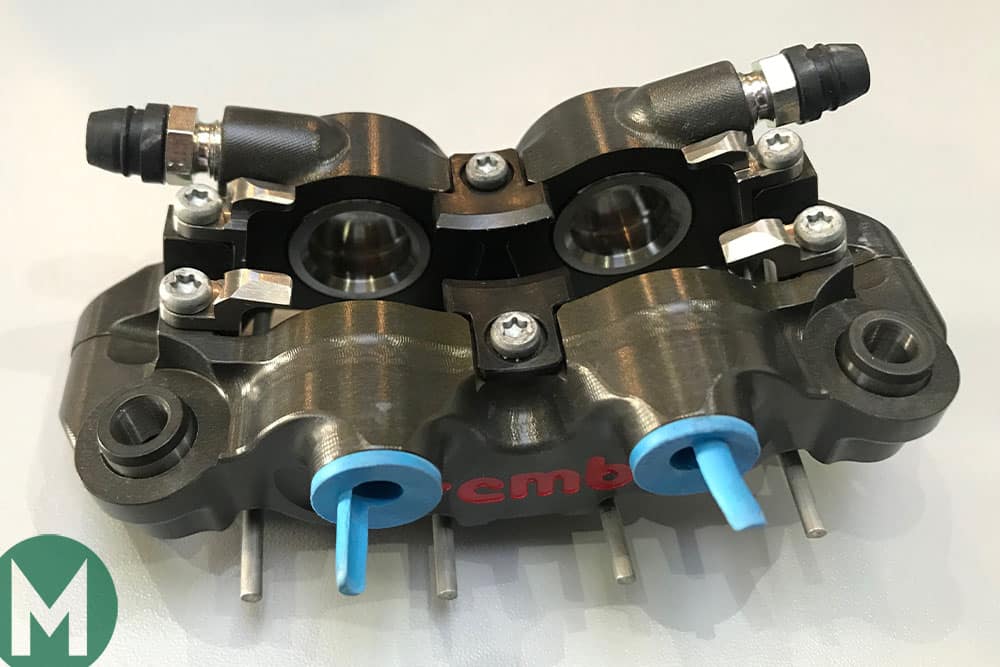
Brembo’s hand/foot operated four-piston rear brake caliper Photo: Oxley
Soon, most MotoGP riders will use scooter-style finger-operated rear brakes, according to Brembo, the Italian company that supplies brakes to the entire MotoGP grid.
Hand-operated rear brakes are nothing new. Mick Doohan switched to a thumb-operated brake in 1993 because his right ankle was fused solid due to injury. Simon Crafar was the first top rider to follow suit because he realised this allowed better control of the rear brake while riding through right-handers when the right foot can’t get to the brake pedal.
In recent years most top riders have tried thumb-operated brakes but it isn’t easy to reprogram the brain to use your left thumb instead of your right foot when you’re braking from 220mph/354km/h.
However, as rear-brake use becomes more important during the critical mid-corner turning phase, more riders are using hand-operated rear brakes, including Fabio Quartararo, Andrea Dovizioso, Danilo Petrucci, Valentino Rossi, Pecco Bagnaia, Jorge Lorenzo and Karel Abraham.
Brembo is working hard on this technology. Most interesting of all are the company’s finger-operated rear brake and its dual-line, four-piston rear caliper, which allows riders to use both hand and foot brakes, with the hand working two pistons and the foot the other too; a good halfway house on the way to solus hand operation. None of this is tech is brand new, but it’s getting more useable for more riders.
Both Rossi and Marc Márquez started using thumb brakes a while back but gave them up as a bad job. Rossi started again in Austria.
“When Valentino first tried the thumb brake there wasn’t enough power,” says Brembo technician Andrea Pellegrini.
“But now we have a better pad compound, developed from WSB, because MotoGP rear discs are steel, like WSB front discs.”
Arguably Brembo’s most important development is the finger-operated brake used this year by Avintia Ducati rider Abraham.
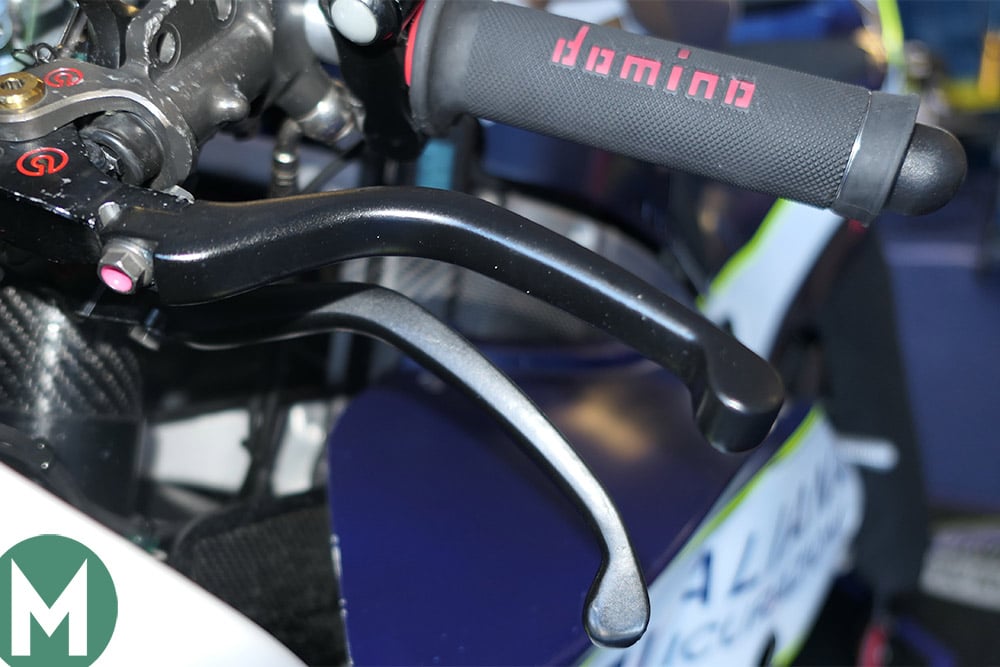
Karel Abraham’s finger-operated rear-brake Photo: Oxley
“I think this system is easier for riders,” adds Pellegrini. “It’s more difficult for riders to push the thumb brake when they’re in the corners and it’s much more natural for them to pull a brake lever like they do when they are riding scooters and bicycles. I think next year many more riders will use this system, probably including Marc Márquez.”
And a finger-operated rear brake makes perfect sense now when riders only use the clutch once during the race; at the start.
Of course, there are better ways for riders to get used to hand-operated rear brakes: equip their training bikes and dirt bikes with the same systems. This is what Crafar did before he started using a hand-operated rear brake on the track. Apparently Rossi now has all his dirt bikes set up with hand rear brakes. He, like more and more riders, knows it’s the way forward.
One team is pushing its riders to remove the foot brake entirely because during cornering it’s easy for the rider to touch the lever when he doesn’t want to. There would also be weight-saving benefits.
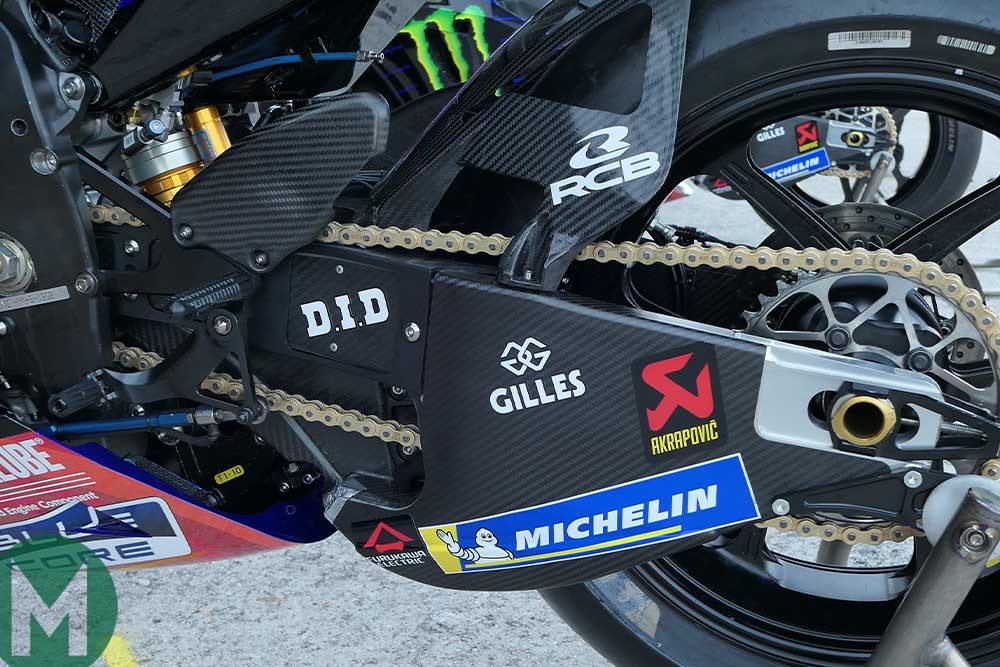
Yamaha’s first carbon-fibre swingarm Photo: Oxley
A few months ago, a senior Yamaha MotoGP staffer said to me, “the M1 is like the Shell logo, it never really changes”.
Finally, at Misano, the YZR-M1 did change. The new parts included the factory’s first carbon-fibre swingarm, a Suzuki-style twin-pipe Akrapovic exhaust and a Ducati-style front-wheel fairing.
Valentino Rossi, who raced with the new swingarm and exhaust, was as surprised as anyone by the flurry of new kit.
“This is more new parts than we’ve had since the end of 2016,” he said.
“In reality, since 2016 we didn’t test anything, or whatever we tested wasn’t clearly better, until this year’s tests at Brno and Misano. Technically speaking that was a very difficult period and the gap to the other manufacturers increased. But since the beginning of this season something has changed – we have a lot of different people from Europe and especially from Japan. It looks like now we feel the effect.”
None of the new parts provided magic improvements, but at least Yamaha seems to be spending money again and inching closer to the leaders.
“I like the new stuff – we are moving in the right direction,” said Rossi. “I have a good feeling with the new swingarm, it’s more precise.”
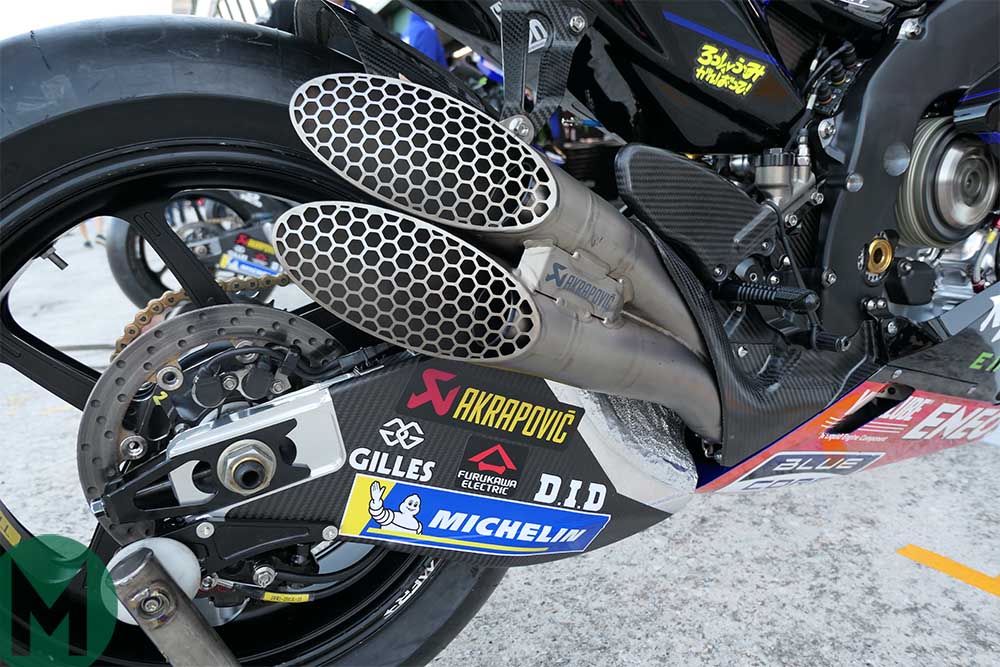
New M1 exhaust. Note also brake caliper’s dual hand/front brake lines Photo: Oxley
Perhaps it was no great shock that all this kit arrived at Misano, because several Yamaha senior management were present, including long-time M1 project leader Masahiko Nakajima, visiting a race for the first time this year.
The biggest surprise was the fact that all four Yamahas – of various different specs – were more competitive than they’ve been for a long time. In fact, Misano was the first time Yamaha had four riders finish in the top five since Aragon 2012.
This didn’t seem so odd at Misano, where the M1 took four consecutive wins between 2011 and 2014, but grip was so low last weekend that the race was 20sec slower than the previous year. Many people assumed the M1 would lose its corner-speed advantage, but in fact, the opposite was true. The nature of the grip seemed to favour the M1’s corner-speed performance over the point-and-squirt performance of the V4s (except with Marc Márquez on board).
Why? Because motorcycles are weird contraptions that rarely conform to accepted engineering logic. Also, perhaps Michelin’s stronger 2019 rubber allows Yamaha riders to use their long cornering arcs without burning the edge of the tyres. And let’s not forget that while Rossi finished 12sec behind the winner, Fabio Quartararo very nearly won the race and Maverick Viñales was only seven-tenths further back.
To highlight the fine line that each machine rides, Suzuki’s GSX-RR had a horrible weekend, right after winning in Britain. The inline-four M1 and GSX-RR are similar in concept and have similar characters, but if the lack of grip didn’t bother Yamaha, it did affect Suzuki.
“More grip is better for us and still our bike doesn’t fit every track,” explained Suzuki technical manager Ken Kawauchi, after Silverstone winner Álex Rins crashed out and Joan Mir finished eighth.
Yamaha may benefit further from Michelin’s latest technology next year. The company’s new-construction 2020 rear slick (which riders evaluated at the Brno and Misano tests and may try once again during Phillip Island practice) is another step stronger, which could give the M1 more support at full lean.
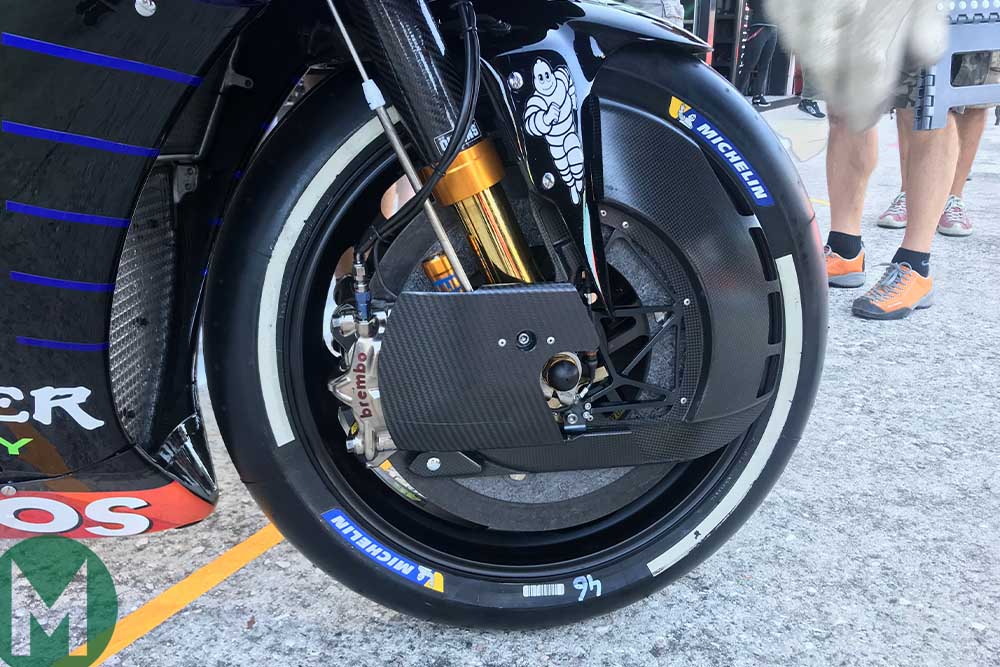
First try-out for M1’s new front-wheel fairing Photo: Oxley
Yamaha’s new front-wheel aero appeared in FP1 at Misano and was never seen again. Presumably, this was just an initial shakedown outing. The wheel fairing is similar to that used since the season-opening Qatar GP by Ducati, but much more neatly executed.
The exquisite carbon-fibre mouldings most likely do two jobs. First, smoothing the turbulence around the front wheel should increase the energy in the air entering the radiator area, which should cool the engine more efficiently and deliver more performance. Therefore this aero increases the horsepower of the engine rather than the slipperiness of the motorcycle.
Second, the mouldings incorporate air scoops that cool the brakes. MotoGP’s latest aerodynamics allow heavier braking which causes higher temperature in the calipers, pads and discs, which can reduce braking power, hence the need for better cooling.
Brembo is also working in this area. At the recent Misano MotoGP tests, several riders tested a redesigned caliper that improves cooling. The caliper will be used next season.
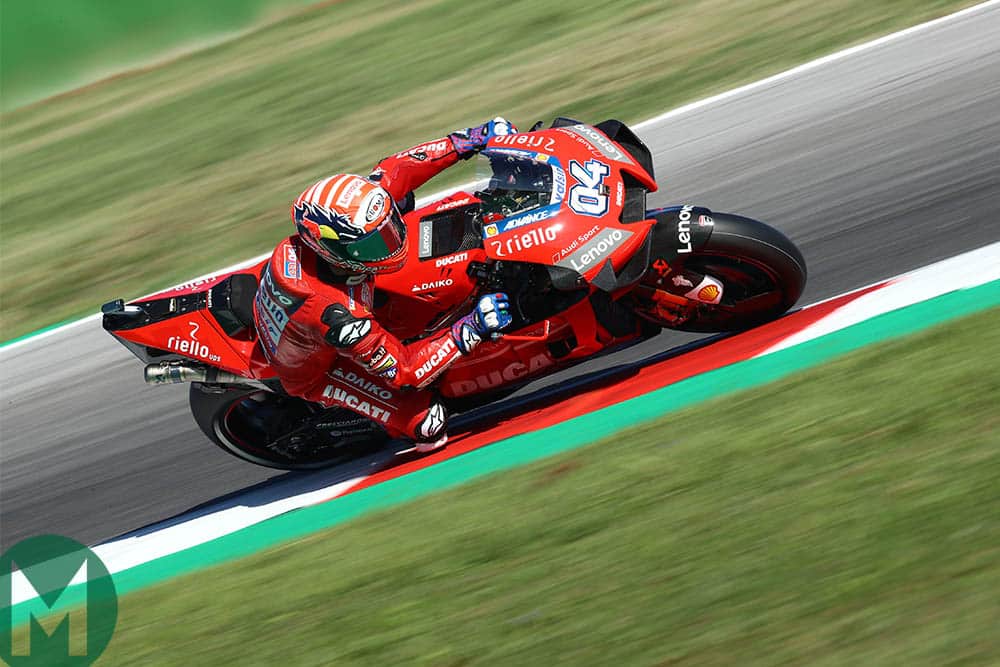
Andrea Dovizioso endured an off-weekend at Misano Photo: Motorsport Images
Andrea Dovizioso’s worst result in a while is indicative of a season in which Ducati has slumped from title challenger to also-ran. True, the 33-year-old Italian has won two races and holds the same second place in the championship he took in 2017 and 2018, but Ducati has slipped further behind Honda, while Yamaha and Suzuki have caught up.
On Sunday, Dovizioso’s race time was 33 seconds slower than his winning time at Misano 2018, whereas Márquez lost only 17 seconds. The track was very slippery, but the lack of grip hurt the in/out grip of the Ducati more than the edge grip of the Yamaha.
The M1 uses a corner-speed U-shaped arc through corners, whereas the Desmosedici uses more of a V-shaped line, making its time in braking and acceleration. But Misano was so slippery that Dovizioso and his fellow GP19 riders couldn’t exploit their usual strengths, because they didn’t have the grip to brake deep or accelerate hard.
“We can’t ride here like we did last year,” explained the former 125cc world champion, who finished sixth, half a second a lap slower than the winner.
“The grip is lower, so we can’t use the grip we usually have in the traction [acceleration] area. The only way to be fast is to use more speed in the middle of the corner so that you arrive in the traction area with more speed, because nobody can really accelerate in the traction area, which is usually the positive of our bike. We can try to be aggressive in the middle of the corner, but then we lose the front very easily – we are locking the front tyre a lot.
“Everybody is in the same situation, but our bike works in a different way to the others, so we are struggling more. Also, our competitors have improved a lot from last year, so all this mix creates this situation.
“The biggest factors are that during this season everyone has improved and every race is different. At Silverstone, we worked really hard during the weekend and after FP4 and morning warm-up we had a chance to fight for the victory. Always, the tyres we get for the weekend affect things a lot.”
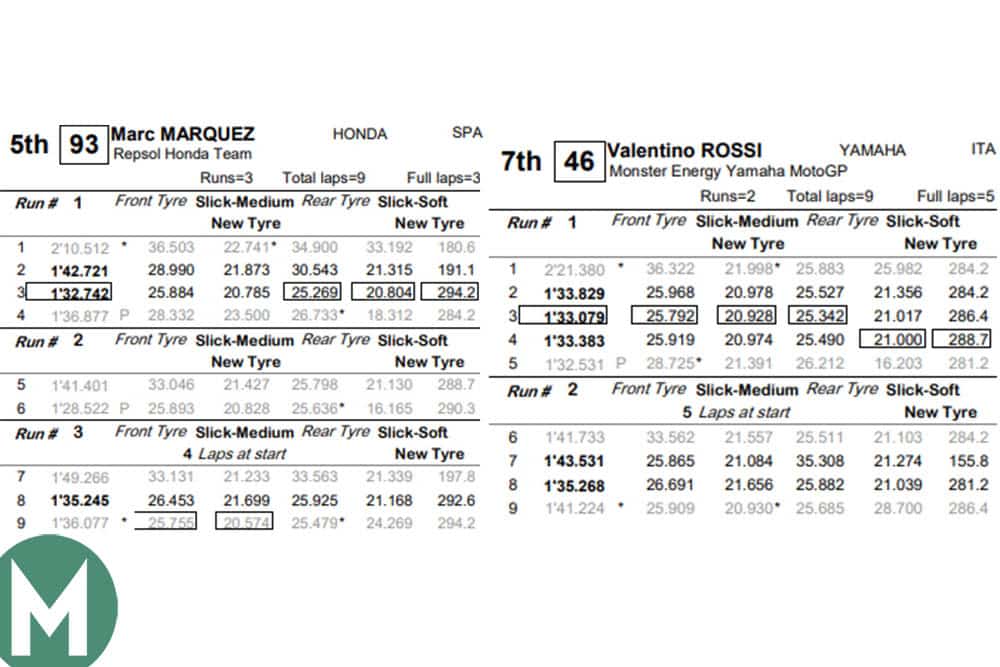
Márquez and Rossi: lap times, four sector times and top speeds during Q2
It’s been a while since Rossi and Márquez have had a run-in with each other, but they had one during the final moments of Saturday’s Q2 qualifying session.
Both riders used different strategies: Rossi stopped once for new rubber, Márquez stopped twice, changing bikes the second time and leaving the pits with 3 minutes 30 seconds to go; enough for two flying laps. At that point Fabio Quartararo was fastest, Franco Morbidelli second, Maverick Viñales third, Márquez fourth and Rossi fifth. Thus both men had work to do if they wanted to start from the front.
During his out-lap, Márquez found Rossi cruising on the back straight, so he slowed and stayed behind the Yamaha, so they started their last two flying laps in that order. Their penultimate laps were similar – Márquez at 1min 35.245sec, Rossi at 1min 35.268sec – and then they had to give it everything on their final laps.
Márquez was 0.15sec quicker than Rossi through the first sector and 0.356sec through sector two: the fastest sector times of the session, which put him on course for pole position. Meanwhile, Rossi was slower than his previous best in both sectors.
That put Márquez level with Rossi as they headed into the daunting 155mph/250km/h Turn 11, where Márquez swept past on the inside.
Rossi didn’t like that and two corners later he dived inside Márquez and ran wide, the world champion getting a mighty wobble on as he tried to maintain control.
Inevitably, both riders thought they were in the right. Anyway, the whole thing became irrelevant when Race Direction announced that both riders had had their final laps cancelled. Rossi had run onto the green at Turn Six, while Márquez had exceeded track limits exiting Turn 11.
And there you have it – all’s fair in love and war.

As Honda rebuilds after its deepest slump, Luca Marini has emerged as a thinking rider whose value goes far beyond the timing screens

Reigning MotoGP champion Jorge Martín completed the 2025 season in 21st place, after a title defence destroyed by multiple injuries

KTM’s Pedro Acosta was one of MotoGP's stars in 2025 aboard his steadily improving RC16. KTM reveals how it went backwards to go forwards, why the purpose of a mass damper is to prevent all the resonances on a MotoGP bike having a party together and why KTM wants them banned

How Ducati’s failure to communicate the reasons behind its 2025 bike troubles created innumerable online conspiracy theories and spoiled what was a glorious season, with Marc Márquez at least